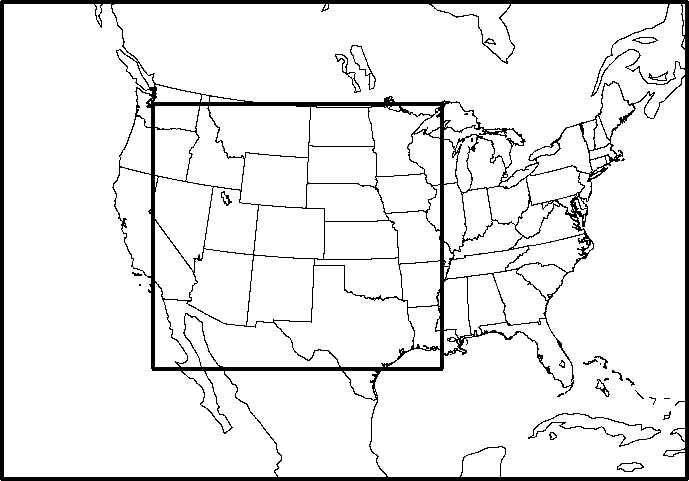Information about CSU real-time WRF model forecasts
UPDATE: Owing to poor forecast performance for ensemble member 5 using the SREF perturbations, this member was changed starting with the 0000 UTC run on 26 May 2017 to use the first positive (i.e., "p1") perturbation of the NCEP Global Ensemble Forecast System for its initial and lateral boundary conditions. The physical parameterizations, etc., remain the same. This information has been included in the table below.
UPDATE: Due to problems that arose with correctly processing observations in WRF-VAR, which led to very unrealistic analyses and forecasts (i.e., spurious tropical cyclones were being predicted very frequently), ensemble member 5 was changed starting with the 0000 UTC run on 1 October 2014. Its initial conditions now come from the NAM analysis, but perturbed with the "em_p1" member of the NCEP Short-Range Ensemble Forecast (SREF) system. The lateral boundary conditions also come from that member of the SREF. The physical parameterizations, etc., remain the same. This information has been included in the table below.
- Currently, these are run out to a 60-hour forecast at 0000 UTC every day, and at 1200 UTC on weekends only. (They are running on desktop iMacs!)
- Currently, there are five ensemble members being run. This number will increase as more computers and storage systems get up and running in my group.
- The configuration is a 2-way nested run of WRF-ARW, version 3.3.1. The domains are shown below, where the outer (coarse) domain has 36-km horizontal grid spacing, and the inner (fine) domain has 12-km horizontal grid spacing.

- All runs have 36 vertical levels (on a stretched grid with higher resolution near the surface)
- All runs use a 144-second timestep on the outer domain, and 48-second timestep on inner grid.
- Currently, the model runs and post-processing finish around 3:00 am Mountain time (0900 UTC). (3:00 pm/2100 UTC for the 12Z runs.) This should become substantially earlier as more computing resources come online in my group.
- The model comparison images shown at the WxChallenge
site may reflect either the coarse grid or the fine
grid, depending on whether the forecast city is located
within the fine grid.
- Details of the configuration of each ensemble member are given in the table below:
| Member
1 |
Member
2 |
Member
3 |
Member
4 |
Member
5 |
Member 6 |
|
| Initial/Boundary conditions | 0.5 degree GFS, BCs updated every 3 hours |
0.5 degree GFS, BCs updated every 3 hours |
40-km NAM, BCs updated every 3 hours |
40-km NAM, BCs updated every 3 hours |
0.5-degree GEFS "p1" perturbation, BCs updated every 3 hours |
COMING SOON! |
|
Cumulus |
Kain-Fritsch |
Grell-Devenyi 3 (G3) |
Betts-Miller-Janjic |
Kain-Fritsch |
G3 |
|
| Boundary layer |
MYJ |
YSU |
MYJ |
MYJ |
YSU |
|
| Microphysics |
WSM 6-class |
Thompson |
Goddard |
Thompson |
Goddard |
|
| Land surface |
Noah |
Noah |
Noah |
Noah |
Noah |
|
| Shortwave radiation |
Dudhia |
Dudhia |
Goddard | Dudhia |
Goddard |
|
| Longwave radiation |
RRTM |
RRTM |
RRTM |
RRTM |
RRTM |
(More info on the WRF physics options can be found on the
WRF website here.)


